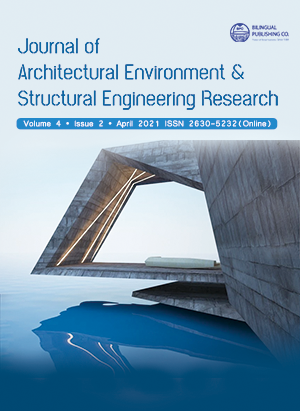-
366
-
207
-
192
-
183
-
181
Mechanical Properties of Polypropylene Fiber Reinforced Concrete under Elevated Temperature
DOI:
https://doi.org/10.30564/jaeser.v4i2.3296Abstract
Apart from many advantages, High Strength Concrete (HSC) has disadvantages in terms of brittleness and poor resistance to fire. Various studies suggest that when polypropylene (PP) fibers are uniformly distributed within concrete, they play an active role in improving spalling resistance of concrete when exposed to elevated temperature while having no adverse effect on its mechanical properties. Therefore, there is a necessity to quantify the effect of the addition of polypropylene fibers in terms of the fiber dosage, the strength of the concrete, and the residual mechanical properties of fiber-reinforced concrete under exposure to high temperature from fire. The study was carried out on three water/cement (w/c) ratios (0.47, 0.36 & 0.20) using granite aggregate for determining short term mechanical properties of Polypropylene fiber reinforced concrete in comparison to control mix. The experimental program includes 100 × 200 mm & 150 x 300 mm cylinders with fiber volume of 0.5%, that were subjected to temperatures exposures of 400 °C and 600 °C for durations of 1 hour. From the results, it was observed that no significant enhancement in mechanical properties such as modulus of elasticity, Poisson’s ratio, split tensile strength, flexural strength, and compressive
Keywords:
High strength concrete; Fiber reinforced concrete (FRC); Polypropylene fibers; Residual mechanical properties; Spalling resistanceReferences
[1] V.V.Arora, Brijesh Singh and Shubham Jain, “Effectof indigenous aggregate type on mechanical properties of high strength concrete” Indian Concrete Journal, Vol. 91, No. 1, pp. 34-44, January 2017, NCCBM, Haryana, India.
[2] V. V.Arora, Brijesh Singh and Shubham Jain, Indian “Experimental studies on short term mechanical properties of high strength concrete” Concrete Journal, Vol. 90, No. 10, pp. 65-75, October 2016, NCCBM, Haryana, India.
[3] Cetin, A. and Carrasquillo, R. L. 1998. HighPerformance Concrete: Influence of Coarse Aggregates on Mechanical Properties, Journal of ACI Materials, 95: 252-261.
[4] Ashour, S. A., “Effect of compressive strength and tensile reinforcement ratio on flexural behavior of highstrength concrete beams,” Engineering Structures, Vol.22, 2000, pp. 413-423.
[5] BALAGURU, P., "Properties and Behavior of Fiber Reinforced Concrete," General Report, Technical Sessions 2, Proceedings of International Symposium on Fiber Reinforced Concrete, Volume III, 1987, pp. 2.48-2.52.
[6] Alhozaimy, A.M.; Soroushian, P.; and Mirza, F. (1996). Mechanical properties of polypropylene fiber reinforced concrete and the effect of pozzolanic materials. Cement and Concrete Composites, 18(2), 85-92.
[7] Bentur A. and Mindess S., 1990, Fibre Reinforced Cementitious Composites, Elsevier Science Publishing Ltd., New York, United State of America.
[8] A. Nishida & N. Yamazaki (1995)." Study on the Properties of High Strength Concrete with Short Polypropylene Fibre for Spalling Resistance". Proceedings of the International Conference on Concrete under Severe Conditions (CONSEC'95). Sapporo, Japan. August. E&FN Spon, London, pp: 1141-1150.
[9] P. Kalifa, G, Chene& Ch. Galle (2001)." HighTemperature Behaviour of HPC with Polypropylene Fibres from Spalling to Microstructure".Cement & Concrete Research. 31, pp: 1487-1499.
[10] Optimal Polypropylene Fiber Content for Improved Compressive and Flexural Strength of Concrete Anthony Nkem Ede1 (Ph.D.) and Abimbola Oluwabambi Ige, Department of Civil Engineering, College of Science and Technology, Covenant University, Canaan Land, KM 10, Idiroko Road, P.M.B. 1023 Ota, Ogun State, Nigeria.
[11] Shihada, S., 2011. Effect of Polypropylene Fibers on Concrete Fire Resistance. Journal of Civil Engineering and Management, Accepted for Publication.
[12] Effects of various dosage of PPF on compressive strength of PMM (sbr), PMM (acrylic) and microconcrete Kamlesh S.Dalal., Modhera, C.D, and S.A. Vasanwala Dept. of Applied Mechanics, S V National Institute of Technology, Ichchhanath, Surat-395007, India.
[13] Optimal Polypropylene Fiber Content for Improved Compressive and Flexural Strength of Concrete Anthony Nkem Ede1 (Ph.D.) and AbimbolaOluwabambi Ige1 1Department of Civil Engineering, College of Science and Technology, Covenant University, Canaan Land, KM 10, Idiroko Road, P.M.B. 1023 Ota, Ogun State, Nigeria.
[14] Md Azree Othuman Mydin and Sara Soleimanzadeh, “Effect of polypropylene fiber content on flexural strength of lightweight foamed concrete at ambient and elevated temperatures,” Pelagia Research Library, Advances in Applied Science Research, 2012, 3 (5):2837-2846.
[15] Roohollah Bagherzadeh, Ph.D., Hamid Reza Pakravan, Abdol-Hossein Sadeghi, Masoud Latifi, Ali Akbar Merati, “An Investigation on Adding Polypropylene Fibers to Reinforce Lightweight Cement Composites (LWC),” Journal of Engineered Fibers and Fabrics, Volume 7, Issue 4 – 2012.
[16] Sideris K K, Manita P and Chaniotakis E Performance of thermally damaged fibre reinforced concretes 27 September 2009 Construction and Building Materials 23 1232-1239.
[17] Sideris K K and Manita P. Residual mechanical characteristics and spalling resistance of fiber-reinforced self-compacting concretes exposed to elevated temperatures 11 January 2013 Construction and Building Materials 41 296-302.
[18] Khaliq W and Kodur V Thermal and mechanical properties of fiber-reinforced high-performance selfconsolidating concrete at elevated temperatures 24 June 2011 Cement and Concrete Research 41 1112-1122.
[19] Xiangjun D, Yining D and Tianfeng W Spalling and Mechanical Properties of Fiber Reinforced Highperformance Concrete Subjected to Fire October 2008 Journal of Wuhan University of Technology-Mater. Sci. Ed 743-749.
[20] Qadi A, Al N S and Sleiman M A Effect of fiber content and specimen shape on residual strength of polypropylene fiber self-compacting concrete exposed to elevated temperatures 10 December 2014 Journal of King Saud University – Engineering Sciences 26 33-39.




 Vikas Patel
Vikas Patel





